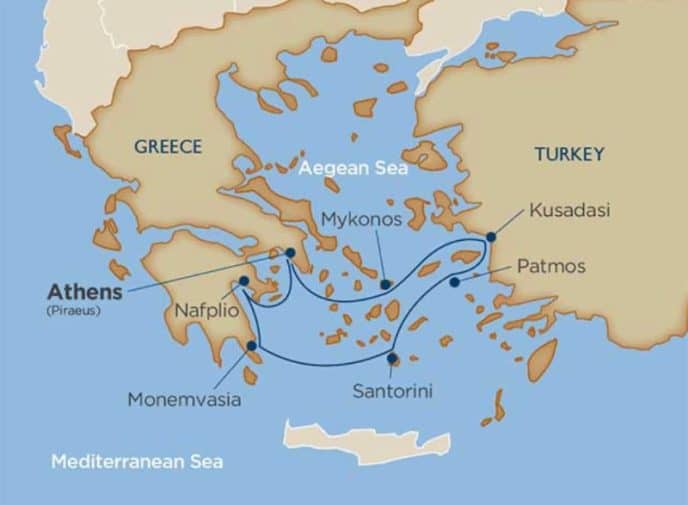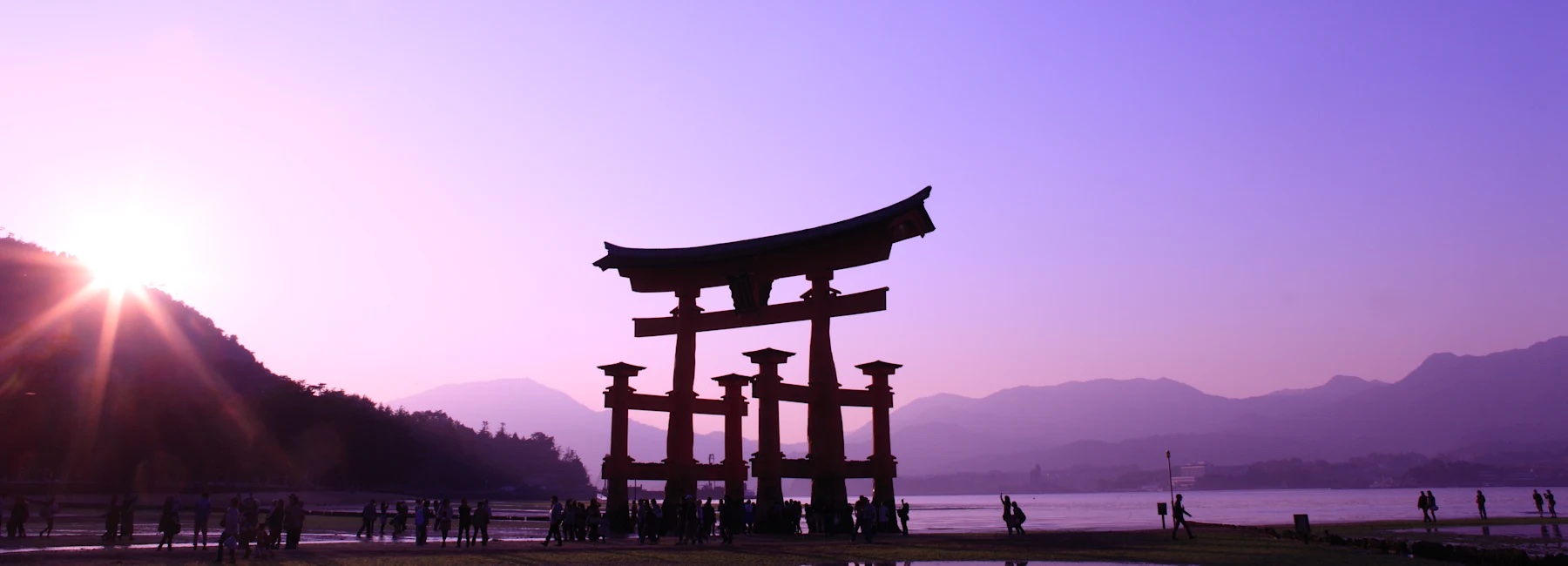Every Sunday, my wife Mary and I like to go to our neighborhood farmers market in Brooklyn, and as a traveler by nature, I’d always stop for a word or two with the Greek olive oil vendor. Sometimes we’d buy a bottle but mostly we’d talk. John wasn’t one for talking about much more than the house he was building in Greece, where he eventually planned to spend eight months of the year. But I’d tell him about our journeys to Europe, to Italy, and how one day we both hoped to travel to his home on the Aegean Sea. John, who gradually became something more than a casual acquaintance, festooned his market stall with photos of a small, mountainous island, the olive grove, a grandson out on a standup paddleboard against a glorious orange-red sunset.
“So, where is your place in Greece?” I asked.
“PEL-OO-PON-EES-US,” he said. Each syllable slower than the one before.
“I have no idea of where you are talking about.”
“You should!” he insisted. “It is out of this world, like no other place in Greece.”

When Mary and I were preparing for our journey on the Greek Isles circle tour aboard the Wind Spirit, we were excited about the places that friends had talked about: Mykonos, Santorini and Ephesus. But when it came to the destinations in the Peloponnese, Monemvasia and Nafplio, I drew a blank. These two places were a mystery to me, but eventually they stood out, too. They may not be as well known as the mainstream tourist islands, but for the traveler looking for quiet, historic splendor away from the crowds, this can be a very good thing. That was certainly something that John emphasized in our many talks with him.
The Peloponnese is in southwestern Greece, a peninsula that begins in Corinth in the north. The landmass resembles a spreading human hand, with the historic castle town of Monemvasia located on the index finger, and Nafplio tucked into the thumb. Perhaps, I thought, that was one of the ways these two places stay out of the travel limelight. They are but two places that don’t glitter like the blue domed, whitewashed buildings in the middle of the Aegean Sea. Rather, we were to learn, they promise delights on a human scale.

That was true of Monemvasia, our first stop in the Peloponnese. Here, we took a tour of the castle town. “One way,” our guide told our small group that gathered before the medieval walled gate. That is what Monemvasia means in Greek, she said as we looked up to where we could see a conduit on the wall that was key to the safeguarding of this island rock. “Some people see this as the Gibraltar of Greece,” she said. While the town within had been governed by the Turks and the Venetians, there was never a shot fired in anger. From that conduit, defenders on the other side of the wall would pour burning sand down upon the invaders — sand that would find its way through the knights’ armor of that time, she said. “While a difficult fact to imagine, this place would not be here in the way that you see it today, had it not been so fiercely defended.”
Inside the walls, a strange calm descended on me. We learned that the lion carvings above the doorways of some of the public buildings actually date from the Venetian occupation of “Monem” town, for almost a century until the mid-1500s. Our guide asked if we were all up for a strenuous walk as part of the tour: to the Hagia Sophia (Holy Wisdom) church — built as a Christian church under the orders of Byzantine emperor Justinian I. Since then, during the years of various occupations, it became a mosque, then a museum, and then a museum again, she explained. But after such trips as the historic tour of Ephesus and a hillside trek to the monastery and museum in Patmos we opted instead to savor the quietude that Monemvasia offered.
Sometimes as a traveler, I seek the quiet pleasures of being a vagabond poet, the travel vision of choice by the writer Jean-Paul Clebert of “Paris Vagabond.” Our tour had stopped away from the steep streets filled with tourists clamoring with smartphones or large guided groups. Instead, we sat in the medieval square. Here, I watched three tiny birds, not sparrows but like them, busily making a nest in an opening above a stone ledge. Above, because the other side of the wall is against the sea, gulls forever soar in the blue, blue sky. Wild caper bushes climb the ancient facades of the restored homes.
Our next day’s short sail took us to Nafplio. Mary and I frequently talk about travel karma and it came up here. We hadn’t encountered the name “Nafplio” outside of the helpful Wind Spirit guide notes on what to see and do in this coastal city up in the Peloponnese “thumb” until the night we were actually sailing there. That’s because we’d borrowed a DVD of the movie, “My Big Fat Greek Wedding,” which neither of us had ever seen before, and began watching it in our cabin.
In the flick, in an early scene in a travel agent’s office, there it was: a classic seawall poster advertising “NAFPLIO” in big block letters. That moment in a nutshell seemed to speak to the lesser known but no less magical promise of the Peloponnese. Here we were only hours from docking, and while Nafplio doesn’t appear to play any part in the lives of the movie’s co-producers Rita Wilson and Tom Hanks, the travel destination did in a way that took us by surprise.

Our visit to Nafplio coincided with the big market day on Sunday. Here we were hoping for that quiet splendor away from the crowds and found it at the market and in the shops in this picturesque coastal town. While rich in history — from the ancient Argonaut expedition to the Trojan War — Nafplio doesn’t put the past forward in the way the Monemvasia castle does. Here is a place that feels homey and immediately accessible, where the comforts are both country-like and urbane.
We walked not far from the port — finally, upon level ground — to the market. For a few hours without a tour guide, we paused in a way that we hadn’t since we embarked days ago from Piraeus harbor. We held hands while listening to the canaries, stopped to catch a whiff of a fragrant melon that we bought for our cabin, as well as an apronful of cherries. The market was rich in scarlet red geraniums, and our personal favorite: grave leaves piled in mounds topped with a stone to keep them just so, not touched by the welcome breezes. Later, we stopped for a cold drink at a café, watching a Greek grandma guiding her towheaded charge in the white gravel bed of a tree-lined street.

Before heading back for the evening aboard the Wind Spirit — our last hurrah with the Piraeus harbor being our next stop — we spotted a bejeweled doorway with an old stone façade. Here was the workshop of Anna and Eleni Singenidi, worry bead makers. I had no idea what to expect inside, but we were dazzled to see countless bracelets in all the colors of the rainbow and then some. The shop clerk laid many different worry beads in our open palms, from mineral stones, olive wood, and coral.
“But what are they for?” I asked.
“Do you have anxieties, worries of any kind?” she asked me.
“Some,” I said, and exchanged an eye roll with Mary.
“Here,” she said, after I’d picked out an Aegean blue color, and showed me how to arrange the beads in both hands, letting them dangle from my fingertips. “Each person is different, just press them with your fingertips, moving them slowly around in your palm.”
I use them now, to ease the strain I find from writing stories like this one. There are many mantras that I recite as I do this. In the beginning I did so with John’s PEL-OO-PON-EES-US, ringing my ear. Because not only does it give me the memory of a destination, of a time away, but the very best thing a traveler can feel: the promise of a certain return.
Editor’s Note: Mary Morris, an award-winning novelist and memorist and her husband Larry O’Connor, a writer and book editor, traveled aboard Windstar Cruises’ Wind Spirit to the Greek Isles. While traveling, they were inspired to write a series of pieces about the experience – both onboard and ashore. If you enjoyed this post, check out their other pieces: What It’s Like: Sailing the Greek Isles on Wind Spirit; Choose Your Adventure: In Santorini the Wonderful Experience of the Caldera; and In Greece, Putting Food First. And we have even more stories on a cruise around Greece.


















































